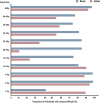Seroprevalence of hepatitis A virus infection in urban and rural areas in Vietnam
- PMID: 40378373
- PMCID: PMC12084049
- DOI: 10.1371/journal.pone.0323139
Seroprevalence of hepatitis A virus infection in urban and rural areas in Vietnam
Abstract
Background/objectives: The prevalence of hepatitis A virus (HAV) is associated with socioeconomic conditions, access to clean drinking water, and improvements in sanitation. In Vietnam, epidemiological data on HAV have been limited over the past two decades. This study aims to assess age-specific HAV seroprevalence across two distinct geographic regions, urban and rural areas, and identify the risk factors associated with HAV seropositivity in Vietnam.
Methods: This cross-sectional seroprevalence study was conducted in two distinct areas in Vietnam. Serological testing for anti-HAV total antibodies was performed, and socio-demographic questionnaires were administered to all participants. The age at the midpoint of population immunity (AMPI) was calculated and analyzed.
Results: A total of 1,281 participants aged 1-80 years were included, with 649 from urban areas and 632 from rural areas. Of the total participants, 33.2% were aged <15 years. Overall, HAV seropositivity was 69.2%, with urban areas exhibiting significantly lower seropositivity (57.9%) compared to rural areas (80.7%) (p < 0.001). The AMPI was 29 years, indicating Vietnam is at intermediate HAV endemicity. Multivariate analysis identified key risk factors for HAV infection, including age and rural residence. Conversely, participants with higher educational levels and those who consumed boiled drinking water were less likely to be HAV seropositive.
Conclusions: The study identified significant differences in the HAV seroprevalence between urban and rural areas, providing critical data for public health officials. These findings highlight the key role of targeted public health interventions and vaccination programs in mitigating HAV infection rates and reducing the disease burden, particularly among high-risk populations in Vietnam.
Copyright: © 2025 Cam Huong et al. This is an open access article distributed under the terms of the Creative Commons Attribution License, which permits unrestricted use, distribution, and reproduction in any medium, provided the original author and source are credited.
Conflict of interest statement
Adriana Guzman-Holst is an employee of GSK and holds shares in GSK. Minh Nguyen is an employee of GSK. All interests have no financial stake in the results of the study. All other authors report no potential conflicts. This does not alter our adherence to PLOS ONE policies on sharing data and materials.
Figures



References
-
- World Health Organization. WHO position paper on hepatitis A vaccines–October 2022. Wkly Epidemiol Rec. 2022;40:493–512.
-
- The Institute for Health Metrics and Evaluation. Global burden of disease Study 2019. 2019. [cited 2023 July; cited 2024 September 24]. Available from: https://ghdx.healthdata.org/gbd-2019
MeSH terms
LinkOut - more resources
Full Text Sources
Medical
Miscellaneous

